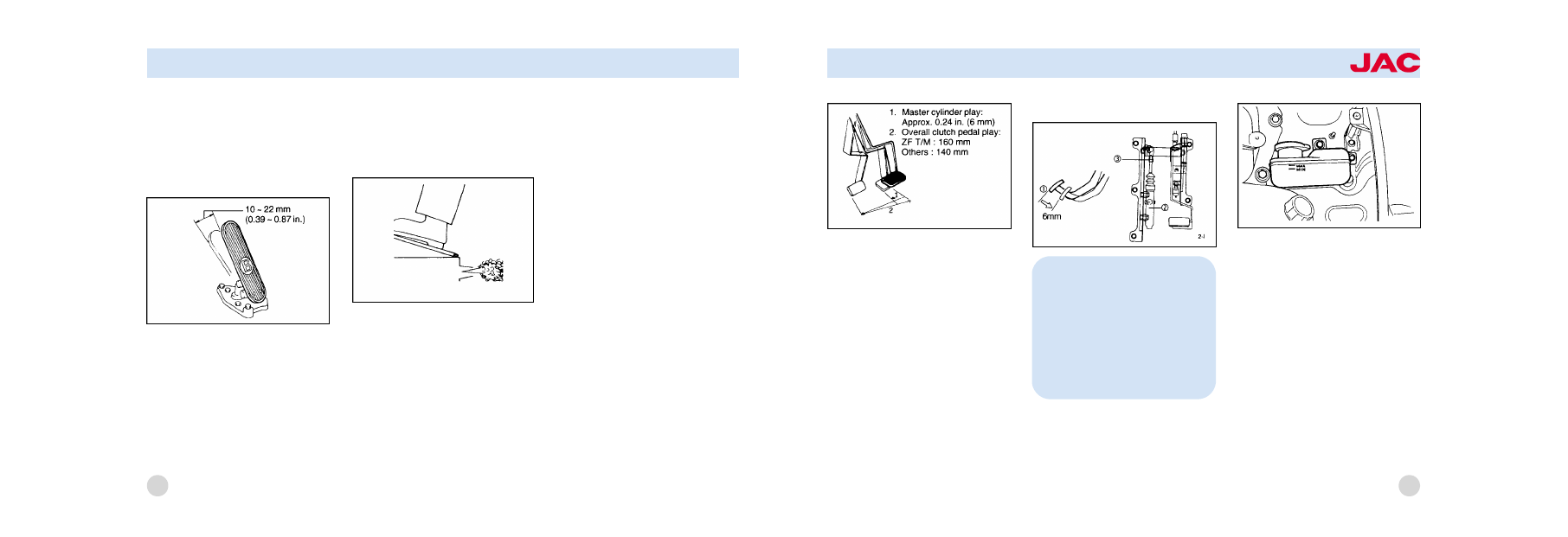JAC Trucks. Manual - part 142

the pedal up to the first resistance
encountered when the pedal is
depressed with your finger. Adjust
this play to about 6 mm (0.24 in.)
by turning the center belt of the
master cylinder push rod.
After
adjusting, firmly tighten the nut on
the center belt while holding the
belt in position with a corench.
1) Master cylinder play:
Approx. 0.24 in. (6 mm)
2) Master cylinder
3) Play adjusting nut
Bleeding of clutch piping
If there is air in the piping, the
clutch will be hard to disengage.
When the fluid reservoir tank has
been emptied, be sure that the
clutch piping is bled. Have an as鄄
sistant in bleeding the piping and
proceed as follows:
1. Fill the clutch fluid reservoir tank
with brake fluid up to the "MAX"
level. Since the level falls during
the bleeding operation, add brake
fluid to prevent emptying the tank.
95
NOTE:
If the adjustment cannot be
made to this play specification,
the clutch disc is worn down to
the service limit. Take the vehi鄄
cle to your nearest service facil鄄
ity for correction.
35 mm, have the steering wheel
adjusted by your nearest Autho鄄
rized Dealer.
CHECKING
BRAKE
PEDAL
FREE PLAY
Check the pedal free play by de鄄
pressing the pedal with finger.The
pedal free play is the stroke made
by the pedal moves until you feel a
change in resistance.This is the
brake pedal free play. The freeplay
should be within the limits speci鄄
fied in the illustration below. If it is
not, have it inspected by your JAC
dealer and adjusted or repaired if
necessary.
CLUTCH PEDAL PLAY
The clutch pedal play will de鄄
crease as the disc wears. If it is
not adjusted, the clutch will slip,
making it impossible to operate the
vehicle. When the clutch pedal
play has decreased to less than
8.3 in. (210 mm), adjustment is re鄄
quired.
Check the pedal play by depress鄄
ing the pedal with finger. Depress鄄
ing the pedal will make you feel re鄄
sistance in two stages. The pedal
play is the stroke made by the
pedal until it reaches the second
stage and is 0.24 to 0.31 in. (6 to
8mm) standard. The play in the
first stage is the master cylinder
play. In the second stage, it is the
clutch booster push rod play. The
play is easier to check when the
compressed air pressure is lower.
If it is out of specification, have it
inspected and adjusted or re鄄
paired if necessary.
荫 Adjust the clutch master cylin鄄
der play, which is the movement of
94
VEHICLE MAINTENANCE REQUIREMENTS